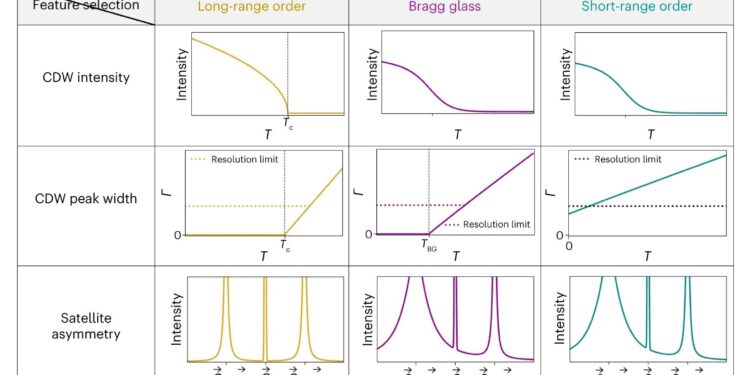CDW to PdXErTe3. ACrystal structure of pure ErTe3. The Te planes have approximately square geometry. The crystal belongs to VSmvsm space group, b designates the out-of-plane axis, and A And vs are the axes in the plane. bPlan25 showing Bragg peaks (circles) and CDW peaks (triangles) in the plane (A*–vs*) reciprocal space. The satellite peaks of CDW-1 (top triangle) and CDW-2 (bottom triangle) are aligned along the vs* And A*axes, respectively. vsPlan diagram (A*–vs*) intensity distribution of the CDW satellite peak pair (at (H,L± qvs)) around a Bragg peak (at ( H, L )), with the following three interesting characteristics: peak intensity, peak width Γ(solid arrow) and the asymmetry of diffuse scattering surrounding the satellite peaks (dotted arrow). d, Summary table of diagnostics allowing classification of the three phases. The first row describes the CDW intensity-temperature trajectory. Only the pristine sample with long-range order shows an abrupt onset, marking the transition temperature Tvs. On the other hand, Bragg glass cannot be distinguished from short-range order because even after the Bragg glass order breaks down with increasing temperature, short-range fluctuations persist ( due to disorder blocking) and contribute to the CDW intensity. The second line illustrates a simplified temperature dependence of the CDW peak width Γ . Credit:Natural physics(2024). DOI: 10.1038/s41567-023-02380-1
Cornell quantum researchers have detected an elusive phase of matter, called the glassy Bragg phase, using large volumes of X-ray data and a new machine learning data analysis tool. This discovery resolves a long-standing question: whether this almost – but not quite – ordered state of Bragg glass can exist in real materials.
The journal “Bragg glass signatures in PdXErTe3 with clustering of X-ray diffraction temperatures (X-TEC)”, is published inNatural physics . The lead author is Krishnanand Madhukar Mallayya, a postdoctoral researcher in the Department of Physics in the College of Arts and Sciences (A&S). Eun-Ah Kim, professor of physics (A&S), is the corresponding author. The research was conducted in collaboration with scientists from Argonne National Laboratory and Stanford University.
Researchers present first evidence of a glassy Bragg phase detected by X-ray scattering, which is a probe that accesses the entirety of a material, as opposed to just the surface of a material, in a density wave systematically disordered charge (CDW), Pd materialXErTe3. They used comprehensive X-ray data and a new machine learning data analysis tool, X-ray Temperature Clustering (X-TEC).
“Despite theoretical predictions thirty years ago, concrete experimental evidence for the presence of CDW Bragg glass in the bulk of the crystal remained missing,” Mallayya said.
Theoretically, there is a clear distinction between three phases: long-range order, Bragg glass and disordered state, Kim said. In the disordered state, the CDW correlation decreases over a finite distance. In the long-range ordered state, the correlation of charge density waves continues indefinitely.
In the Bragg glass phase, Kim continues, the CDW correlation decays so slowly that it will only disappear completely at infinite distances.
“The challenge is to detect these distinctions from experimental data that also reflect real-world issues such as noise and the finite resolution of the experimental setup,” Kim said.
Researchers overcame key challenges through strategic synergy between materials, data and machine learning tools. On the materials front, they found, in collaboration with Stanford scientists, a family of CDW materials that will allow a systematic study with dirt control for use in the experiment: PdXErTe3. On the data side, they collected enormous amounts of data at Argonne National Laboratory in collaboration with Argonne scientists.
On the machine learning front, they used X-TEC, a machine learning tool, to analyze the huge volume of data with a scalable and automated approach.
“An experimental detection of the glassy Bragg phase by X-ray diffraction resolved the open question regarding the fate of the CDW order subjected to dirt,” Mallayya said.
Beyond the specific scientific problem, the paper presents a new mode of research in the era of big data, Kim said: “With machine learning tools and data science perspectives, we can tackle difficult questions and find subtle signatures thanks to a global approach. data analysis.”
The researchers wrote that this detection of Bragg glass order and the resulting phase diagram significantly advances our understanding of the complex interplay between disorder and fluctuations. Additionally, using X-TEC to target fluctuations through high-throughput measurement of “spike propagation” can revolutionize the way fluctuations are studied in scattering experiments.
More information:
Krishnanand Mallayya et al, Bragg glass signatures in PdXErTe3 with grouping of X-ray diffraction temperatures,Natural physics(2024). DOI: 10.1038/s41567-023-02380-1
Provided by Cornell University
Quote: Physicists detect elusive ‘Bragg glass’ phase with machine learning tool (February 9, 2024) retrieved February 9, 2024 from
This document is subject to copyright. Apart from fair use for private study or research purposes, no part may be reproduced without written permission. The content is provided for information only.



